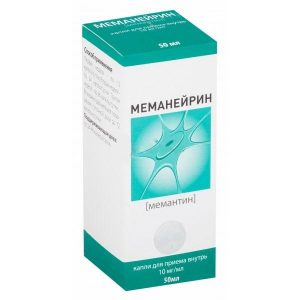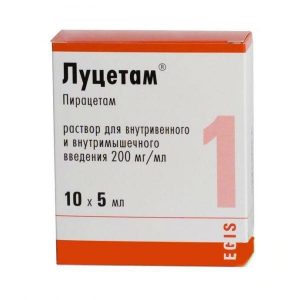Description
Pharmacological action of
Pharmacodynamics of
It is believed that the therapeutic effect of aripiprazole in schizophrenia and type 1 bipolar disorder is due to a combination of partial agonistic activity against D2-dopamine and 5HT1a-serotonin antagonists of antagonist-2 antagonists. Aripiprazole in experiments on animals showed antagonism in relation to dopaminergic hyperactivity and agonism in relation to dopaminergic hypoactivity. Aripiprazole has high in vitro affinity for D2- and D3-dopamine receptors, 5HT1a- and 5HT2a-serotonin receptors, and moderate affinity for D4-dopamine, 5HT2c and 5HT7-serotonin receptors and H1-adrenoreceptors and H1. Aripiprazole is also characterized by moderate affinity for serotonin reuptake sites and a lack of affinity for m-cholinergic receptors. Some of the clinical effects of aripiprazole may be due to interaction with receptors other than dopamine and serotonin.
When administered orally aripiprazole in healthy volunteers at a dose of 0, 5 to 30 mg once a day for 2 weeks, a dose-dependent decrease in the binding of 11C-raclopride, the ligand of the D2 / D3-dopamine receptors, to the caudate nucleus and the fence is observed according to positron emission tomography.
Pharmacokinetics
Absorption
After oral administration, aripiprazole is rapidly absorbed, while its maximum plasma concentration is reached after 3-5 hours. Aripiprazole undergoes a minimal degree of presystem metabolism. The absolute bioavailability of the tablets is 87%. High fat foods do not affect the pharmacokinetics of aripiprazole.
Distribution
Aripiprazole is extensively distributed in tissues, with an apparent volume of distribution of 4.9 L / kg, indicating a significant extravascular distribution. At therapeutic concentrations in the blood, aripiprazole and its main metabolite, dehydroaripiprazole, are more than 99% bound to plasma proteins, mainly albumin.
Metabolism
Aripiprazole is metabolized in the liver in three ways: dehydrogenation, hydroxylation and N-dealkylation. According to in vitro studies, aripiprazole dehydrogenation and hydroxylation occurs under the action of the CYP3A4 and CYP2D6 isoenzymes, and N-dealkylation is catalyzed by the CYP3A4 isoenzyme. Aripiprazole is the main active ingredient in the blood. At equilibrium, the area under the concentration-time (AUC) curve of dehydroaripiprazole is about 40% of the aripiprazole plasma AUC.
Excretion
The average half-life (T1 / 2) of aripiprazole is approximately 75 hours in patients with high activity of the CYP2D6 isoenzyme and approximately 146 hours in patients with low activity of this isoenzyme. The total clearance of aripiprazole is 0.7 ml / min / kg, mainly due to the excretion of
liver. After a single oral administration of labeled [14C] aripiprazole, approximately 27% of the radioactivity is determined in the urine and approximately 60% in the feces. Less than 1% of unchanged aripiprazole is determined in the urine, and approximately 18% of the accepted dose is excreted unchanged in the feces.
Pharmacokinetics in special patient groups
Use in children
The pharmacokinetics of aripiprazole and dehydroaripiprazole in children from 10 to 17 years old was the same as in adults after adjusting for differences in body weight.
Elderly patients
There were no differences in the pharmacokinetics of aripiprazole in adult patients with schizophrenia and in healthy volunteers due to age.
Sex
There were no differences in the pharmacokinetics of aripiprazole in adult patients with schizophrenia and in healthy volunteers due to gender.
Smoking and Race
There are no clinically significant differences in the pharmacokinetics of aripiprazole depending on race and smoking.
Impaired renal function
The pharmacokinetic parameters of aripiprazole and dehydroaripiprazole in patients with severe kidney disease do not differ from those in healthy volunteers.
Impaired liver function
After a single dose of aripiprazole by individuals with varying severity of liver cirrhosis (Class A, B and C according to the Child-Pugh classification), there was no significant effect of impaired liver function on the pharmacokinetics of aripiprazole and dehydroaripiprazole, however, only three patients with decompensated cirrhosis of the liver (Class C according to the Child-Pugh classification) were involved in the study, which is impossible to draw final conclusions about the metabolic activity of the liver in patients with decompensated cirrhosis.
Indications
Schizophrenia: acute attacks and maintenance therapy
Type I bipolar disorder: manic episodes for the prevention and maintenance of therapy relapse in patients with type I bipolar disorder, recent
manic or mixed episode Supplement to lithium or valproic acid therapy for treating manic or mixed episodes of type I bipolar disorder with or without psychotic symptoms and supportive therapy to prevent relapse in patients with type I bipolar
Supplement antidepressant therapy for major depressive disorder
Contraindications
Hypersensitivity to aripiprazole or to any component of the drug
under 18 years old
lactase deficiency, rare hereditary galactosemia, glucose-galactose malabsorption.
Caution
In patients with cardiovascular diseases (coronary heart disease or myocardial infarction, heart failure and conduction disturbances), cerebrovascular diseases and conditions, predisposing to arterial hypotension (dehydration, hypovolemia and taking antihypertensive drugs) due to the possibility of developing orthostatic hypotension in patients with convulsive attacks or suffering from diseases in which seizures are possible in patients with an increased risk of hyperthermia (for example, during intense physical exertion, overheating, taking m-anticholinergic antagonists, with dehydration due to the ability of antipsychotics to disrupt thermoregulation) in patients with an increased risk of aspiration pneumonia due to p ska violation of the motor function of the esophagus and aspiration in patients who are obese, and the presence of diabetes in the family history in patients at high risk of suicide (psychotic disorders, bipolar disorders, major depressive disorder) in people aged 18-24 due to the risk of developing suicidal behavior.
Special instructions
The therapeutic effect of antipsychotic drugs develops within a few days to several weeks. During this period, it is necessary to monitor the patient’s condition.
Suicidal attempts.
Phenomena of suicidal behavior are characteristic of psychosis and mood changes, in some cases it is observed immediately after the start or change of treatment with antipsychotic drugs, including treatment with aripiprazole. When treating with antipsychotic drugs, it is necessary to monitor patients, those at high risk. An epidemiological study showed that patients with schizophrenia or bipolar disorder did not show an increased risk of suicidality with aripiprazole compared with other antipsychotic drugs. There is insufficient clinical data to assess this risk in younger patients (under the age of 18 years), however, there is reason to believe that the risk persists after 4 weeks of treatment with antipsychotic drugs, including aripiprazole.
Cardiovascular disease.
Aripiprazole should be used with caution in patients with cardiovascular diseases (myocardial infarction, coronary heart disease, heart failure, history of cardiac conduction disturbances), cerebrovascular disorders, conditions, predisposing to arterial hypotension (dehydration, hypovolemia, therapy with antihypertensive drugs) or hypertension, including essential or malignant.
Cases of venous thromboembolism have been reported with antipsychotic medications. Since patients treated with antipsychotic drugs often have acquired risk factors for the development of venous thromboembolism, it is necessary to identify all possible risk factors for the development of venous thromboembolism before and during treatment with Ariprizol ® with preventive measures.
Conductivity disorders.
In clinical studies of aripiprazole, the incidence of QT prolongation was comparable to the placebo group. Aripiprazole, like other antipsychotic drugs, should be used with caution in patients having a family history of prolonged QT interval.
tardive dyskinesia.
In clinical trials lasting less than 1 year, infrequent cases of dyskinesia requiring urgent treatment were observed during treatment with aripiprazole. If a patient develops signs and symptoms of tardive dyskinesia during treatment with Ariprizol ®, consideration should be given to reducing the dose or stopping treatment.
Symptoms of dyskinesia may temporarily increase or even appear for the first time after discontinuation of therapy.
Other extrapyramidal disorders.
Akatisia and parkinsonism have been observed in clinical studies of aripiprazole in children. In the event of signs and symptoms of other extrapyramidal disorders, consideration should be given to reducing the dose of aripiprazole, followed by monitoring the patient.
Malignant antipsychotic syndrome (CNS).
Malignant antipsychotic syndrome is a potentially life-threatening combination of symptoms associated with the use of antipsychotic drugs. In clinical studies during treatment with aripiprazole, rare cases of CNS were observed, which is manifested by hyperpyrexia, muscle rigidity, mental disorders and instability of the autonomic nervous system (irregular pulse and blood pressure, tachycardia, sweating, cardiac arrhythmia). In addition, in some cases, there is an increase in CPK activity, myoglobinuria (rhabdomyolysis) and acute renal failure. In the event of symptoms of CNS or unexplained fever, all antipsychotics, including the drug Ariprizol ®, should be canceled.
Cramps.
In clinical studies during treatment with aripiprazole, infrequent cases of seizures were observed. Therefore, aripiprazole should be used with caution in patients with a history of seizures and a risk of their development.
Psychoses associated with senile dementia.
Three placebo-controlled clinical trials of aripiprazole in elderly patients (mean age 82.4 years, age range 56-99 years) with psychosis due to Alzheimer’s disease showed an increased risk of death compared with the placebo group. Mortality when taking aripiprazole was 3.5% compared with 1.7% in the placebo group. Although the causes of death varied, the main causes of most deaths were either disorders of the cardiovascular system (including heart failure, sudden death), or the development of infection (including pneumonia).
In the same clinical studies in elderly patients (mean age 84 years, age range 78-88 years), the development of cerebrovascular adverse reactions (including stroke, transient ischemic attack) was reported, including with a fatal outcome. Overall, cerebrovascular adverse reactions were observed in 1.3% of patients treated with aripiprazole, compared with 0.6% of patients receiving placebo. This difference was not statistically significant. However, one of these fixed-dose studies of aripiprazole revealed a significant dose relationship with cerebrovascular adverse reactions.
Ariprizol ® is not recommended for use in patients with dementia-related psychoses.
Hyperglycemia and diabetes.
hyperglycemia, in some cases, pronounced and accompanied by ketoacidosis or fatal hyperosmolar coma, was noted in patients taking atypical antipsychotics. The relationship between the intake of atypical antipsychotics and disorders of the hyperglycemic type remains unclear. In clinical studies of the use of aripiprazole, there was no significant difference in the frequency of adverse reactions accompanied by hyperglycemia (including diabetes) or in the change in laboratory glycemic values compared with the placebo group.
Patients diagnosed with diabetes mellitus should take blood glucose concentrations regularly when taking atypical antipsychotics.
Patients who have risk factors for developing diabetes mellitus (obesity, family history of diabetes), when taking atypical antipsychotics, they should determine the concentration of glucose in the blood at the beginning of the course and periodically in the course of taking the drug. Patients taking atypical antipsychotics require constant monitoring of symptoms of hyperglycemia (increased thirst, increased urination, polyphagy, weakness). Particular attention should be paid to patients with diabetes and risk factors for its development.
hypersensitivity.
As with other drugs, hypersensitivity reactions in the form of allergic symptoms may develop with aripiprazole.
Weight gain.
Weight gain is usually observed in patients with schizophrenia and bipolar mania due to the development of concomitant diseases, the use of antipsychotic drugs, which cause an increase in body weight, an unhealthy lifestyle, which can lead to acute complications. Cases of weight gain have been reported in the post-marketing period in patients who took aripiprazole. Typically, these adverse reactions have been observed in patients with significant risk factors, such as diabetes mellitus, thyroid disease, or pituitary adenoma. In clinical studies, aripiprazole did not cause a clinically significant increase in body weight.
In clinical studies of adolescent patients with bipolar mania with aripiprazole, body weight increased after 4 weeks of treatment. Constant body weight monitoring is needed in adolescent patients with bipolar mania. If weight gain is clinically significant, it is necessary to reduce the dose of aripiprazole.
Dysphagia.
When using antipsychotics, there have been cases of violations of the motility of the esophagus and, as a result, aspiration pneumonia. The drug should be prescribed with caution to patients with risk factors for aspiration pneumonia.
The pathological attraction to gambling.
During the post-registration period, pathological gambling addiction was reported in patients taking aripiprazole, regardless of whether these patients had a history of gambling. Patients with a history of pathological gambling may be at increased risk of developing this disorder and should be closely monitored with aripiprazole.
lactose.
The drug Ariprizol ® contains lactose, therefore it is not recommended for patients with rare hereditary diseases associated with galactose intolerance, lactase deficiency or glucose-galactose malabsorption.
Patients with concomitant attention deficit hyperactivity disorder (ADHD).
Despite the high frequency of the combination of type I bipolar disorder and ADHD, there is very limited data on the safety of the simultaneous use of aripiprazole and psychostimulants, so care should be taken if they are used together.
Effect on the ability to drive vehicles and mechanisms
As with other antipsychotics, when prescribing aripiprazole, the patient should be warned about the dangers of working with moving mechanisms and driving.
Composition
One tablet contains:
Active ingredient:
aripiprazole 10.00 / 15.00 / 30.00 mg.
Excipients:
lactose monohydrate – 61.23 / 91.53 / 183.69 mg,
corn starch – 10.45 / 15.675 / 31.35 mg,
microcrystalline cellulose – 10.45 / 15.675 / 31.35 mg ,
hyprolose – 1.90 / 2.85 / 5.70 mg,
magnesium stearate – 0.95 / 1.425 / 2.85 mg,
dye iron oxide red (E172) (for dosages of 10 mg and 30 mg) – 0.02 / 0, 06 mg,
dye iron oxide yellow (E172) (for a dosage of 15 mg) – 0.345 mg.
Dosage and administration of
Schizophrenia
The recommended starting dose is from 10 mg to 15 mg once a day, regardless of food intake. The maintenance dose is 15 mg per day. In clinical studies, the effectiveness of the drug in doses from 10 mg to 30 mg per day is shown. The maximum daily dose should not exceed 30 mg.
Manic episodes in bipolar disorder
As a monotherapy, the recommended starting dose is 15 mg once daily, regardless of food intake. If necessary, a dose change should be carried out with an interval of at least 24 hours. Clinical studies have shown the effectiveness of the drug in doses of 15 mg to 30 mg per day for 3-12 weeks. The safety of the drug in doses of more than 30 mg per day in clinical trials was not evaluated.
When observing patients with type I bipolar disorder who underwent a manic or mixed episode who showed stabilization of symptoms while taking aripiprazole for 6 weeks at a dose of 15 mg per day or 30 mg per day with an initial dose of 30 mg per day, then – 6 months and beyond – for 17 months, the beneficial effect of such supportive therapy has been established. Patients should be examined periodically to determine the need for continued maintenance therapy.
Supplement to lithium or valproic acid therapy for bipolar disorder type I
Recommended starting dose is from 10 mg to 15 mg once a day, regardless of food intake. The maintenance dose is 15 mg per day. The dose may be increased to 30 mg per day, depending on clinical indications.
When observing patients with type I bipolar disorder, the beneficial effect of maintenance therapy with aripiprazole at a dose of 10 mg to 30 mg per day was established as a supplement to therapy with lithium or valproic acid preparations.
Patients should be examined periodically to determine the need for continued maintenance therapy.
Supplementary therapy for major depressive disorder
Recommended starting dose is 5 mg per day, regardless of food intake.
If necessary and well tolerated, the daily dose can be increased weekly by 5 mg to a maximum of not more than 15 mg per day.
The duration of therapy for all the above indications has not been established. It is necessary to regularly examine the patient for the possibility of discontinuing therapy.
Use of the drug in special patient groups
Patients with impaired renal function. No dose adjustment is required.
Patients with impaired liver function.
No dose adjustment needed.
In patients with severely impaired liver function, a dose of 30 mg is prescribed with caution.
Patients over the age of 65.
No dose adjustment needed.
Effect of patient gender on dosing regimen.
The dosage regimen for patients of both sexes is the same.
The effect of smoking on the dosing regimen.
Dosing regimen for smokers and non-smokers is the same.
Dosing regimen with concomitant therapy with
With the simultaneous use of aripiprazole and potent inhibitors of the isoenzyme CYP3A4 (ketoconazole, clarithromycin), the dose should be reduced by 2 times when canceling inhibitors of the isoenzyme CYP3A4, the dose should be increased.
With the simultaneous use of aripiprazole and powerful inhibitors of the isoenzyme CYP2D6 (quinidine, fluoxetine, paroxetine), the dose should be reduced by 2 times when canceling inhibitors of the isoenzyme CYP2D6, the dose should be increased.
If the drug is prescribed as adjunctive therapy for major depressive disorder, the drug should be used without changing the dosage regimen.
With the simultaneous use of the drug and potent inhibitors of isoenzymes CYP2D6 (quinidine, fluoxetine, paroxetine) and CYP3A4 (ketoconazole, clarithromycin), the dose should be reduced to 25% of the usual dose. When canceling inhibitors of isoenzymes CYP3A4 and / or CYP2D6, the dose should be increased.
With the simultaneous use of the drug and powerful, moderate or weak inhibitors of the isoenzymes CYP3A4 and CYP2D6, the dose of the drug can be initially reduced to 25% of the usual dose, and then increased to achieve an optimal clinical result.
When administering the drug to patients with low activity of the CYP2D6 isoenzyme, the initial dose should be reduced by half, and then increased to achieve an optimal clinical result. With the simultaneous use of the drug and a potent inhibitor of the CYP3A4 isoenzyme in patients with low activity of the CYP2D6 isoenzyme, the dose should be reduced to 25% of the usual dose.
With the simultaneous use of the drug and potential inducers of the CYP3A4 isoenzyme (carbamazepine), the dose should be increased by 2 times. After stopping induction of CYP3A4 isoenzyme inducers, the dose should be reduced to the recommended one.
Side effects of
The most common side effects in placebo-controlled clinical trials are akathisia and nausea, each of which was observed in more than 3% of patients taking aripiprazole.
The following side effects are more common ( 1/100) compared with placebo or identified as possible clinically significant side effects (*).
The following classification is used to indicate the frequency of side effects: often ( 1/100 and 1/10) and infrequently ( 1/1000 and 1/100):
Mental disorders:
often – anxiety, insomnia, anxiety
infrequently – depression *, increased sexuality.
Disorders of the nervous system:
often – extrapyramidal disorders, akathisia, tremor, dizziness, drowsiness, sedation, headache.
Disorders of the organ of vision:
often – blurred vision infrequently – diplopia.
Disorders of the cardiovascular system:
infrequently – tachycardia *, orthostatic hypotension *.
Disorders of the gastrointestinal tract:
often – dyspepsia, vomiting, nausea, constipation, hypersecretion of saliva.
Common Disorders:
is often fatigue.
Post-marketing surveillance
The following adverse reactions have been reported in post-marketing studies. The frequency of adverse reactions is considered unknown, since it cannot be estimated based on available data.
From the hemopoietic organs: leukopenia, neutropenia, thrombocytopenia.
On the part of the immune system: allergic reactions (anaphylactic shock, angioedema, including inflammation of the tongue, swelling of the tongue, swelling of the face, itching or hives).
From the endocrine system: hyperglycemia, diabetes mellitus, diabetic ketoacidosis, diabetic hyperosmolar coma.
From the side of metabolism and nutrition: weight gain, weight loss, anorexia, hyponatremia.
Mental disorders: agitation, nervousness, pathological addiction to gambling, attempted suicide, suicidal thoughts, committed suicide.
From the nervous system: speech disorder, malignant antipsychotic syndrome, seizures, serotonin syndrome.
From the cardiovascular system: prolongation of the QT interval, ventricular arrhythmia, sudden death, cardiac arrest, tachycardia, bradycardia, fainting, increased blood pressure, thromboembolism (including pulmonary embolism and deep vein thrombosis).
From the respiratory system: oropharyngeal spasm, laryngospasm, aspiration pneumonia.
From the gastrointestinal tract: pancreatitis, dysphagia, heaviness in the abdomen, diarrhea.
From the side of the liver and biliary tract: liver failure, jaundice, hepatitis, increased activity of alanine aminotransferase (ALT) and aspartate aminotransferase (AST).
From the skin and subcutaneous tissues: rash, photosensitivity, alopecia, hyperhidrosis.
From the musculoskeletal system: rhabdomyolysis, myaglia, muscle weakness.
From the urinary system: urinary incontinence, urinary retention.
From the reproductive system: priapism.
General disorders: temperature regulation disorders (including hypothermia, pyrexia), chest pain, peripheral edema, increased activity of creatine phosphokinase (CPK), increased blood glucose, fluctuations in blood glucose, elevated levels of glycogemoglobin.
Storage conditions
Store at a temperature not exceeding 25 ° C. Keep out of the reach of children!
Expiration
3 years.
Do not use after expiration date.
Terms and conditions otpuska from
pharmacies Prescription
dosage form
ta
appointment
Dlya vzrosl h in naznacheniyu Vracha
Indications
Manic-depressive psychosis, Mental disorders, Schizophrenia




